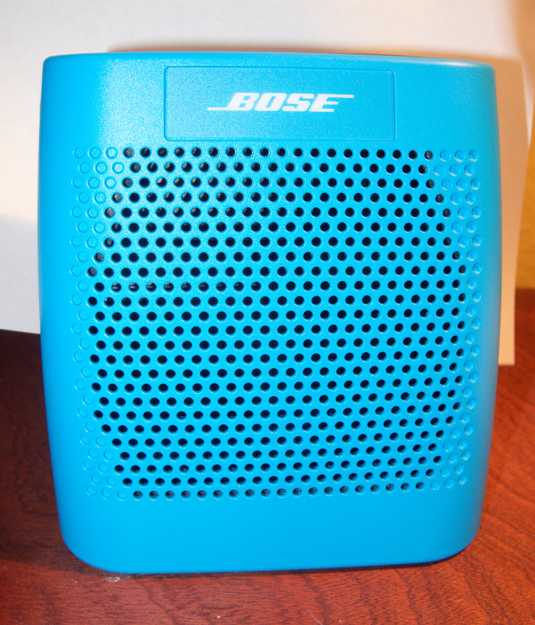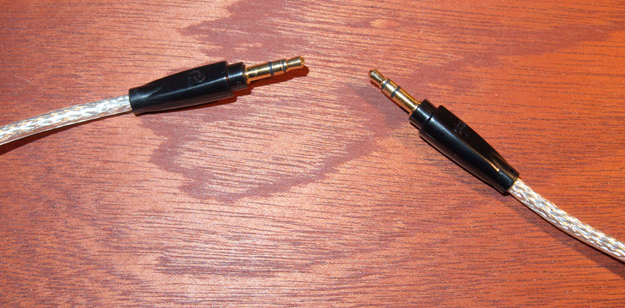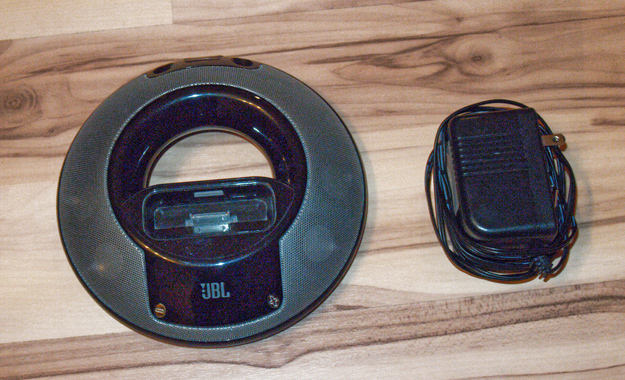Bose SoundLink Color Bluetooth Speaker — as Used with Non-Bluetooth Laptop Computer — a Review
© 2015 Peter Free
18 November 2015

Using the Bose SoundLink Color — with 2.5mm audio-cabled non-Bluetooth devices
This speaker has some mildly annoying operational issues, at least in the audio-cabled way that I use it. And the SoundLink Color’s output has too much base for my taste.
Everything sounds as if it is coming from inside an oak barrel. The inside-a-barrel quality muddies clarity just enough for me to continually notice that the speaker falls short.
Caveat — maybe I am too old and crotchety
I may dislike the oak barrel sound effect more than most people do.
I grew up listening to classical music, thanks to my concert pianist-talented mother. Especially to piano and violin. My ear was early tuned to being able to discern nuance, rather than simply losing itself in physically reverberating pounding.
Mr. Brush, writing at Amazon.com, summarized the distinction:
Way too much bass! It's amazing how much bass comes out of such a small speaker. There is clearly some heavy duty low end equalization going on inside the box.
I'm sure it sounds great for today's bass oriented music, however...many music genres do not benefit from such aggressive and unnatural bass boost. Things like jazz, classical, and latin music all become sounding unrealistically bottom heavy.
My workaround it to eq audio from my iTunes app but stuff from the internet that doesn't come through iTunes (like radio stations off the web) don't sound good.
© 2015 Mr. Brush, Way Too Much Bass Boost, Amazon.com (05 May 2015) (extracts)
My purpose in buying the SoundLink
I use a non-Bluetooth (Windows 7) laptop as a desk computer. It is attached to a larger monitor that lacks speakers. The laptop is far enough away that it is difficult to hear, especially over its fan.
I wanted an external speaker mostly to listen to the audio portion of YouTube instructional videos.
Uninformative Bose packaging
In keeping with the too casual practices of many tech manufacturers, the Soundlink’s box does not explicitly advertise that the SoundLink is compatible with non-Bluetooth input.
The packaging mine came in had no picture of the speaker’s two ports. It showed only a USB cable and an apparently associated AC-DC power adapter as additional contents. Based on reading the box, one would conclude that the speaker is only Bluetooth compatible.
Fortunately, the brick and mortar vendor had a SoundLink on physical display. I could see a 2.5mm port in addition to the speaker’s power slot. This combination, I surmised, meant that I could use it on a computer that lacked Bluetooth capability. So I brought the new speaker home.
I hooked the SoundLink to a laptop via the latter’s 2.5mm headphone port. This requires only a cable with 2.5mm male connectors at both ends.

Sound performance — too bassy
The speaker works well enough for non-singing voices. However with regard to music, audiophiles may fall into different camps, depending upon their affection for muddying bass.
Compared with an old JBL “on Stage II”
I compared the SoundLink’s output with an older JBL on Stage II.

The JBL is an iPod docking speaker. It allows alternative devices (other than the iPod) to play via the same 2.5mm audio cable that I had been using with the Bose.
I hooked both speakers up to the laptop, one after the other, and listened to identical tracks of speaking voice and various kinds of music.
The JBL delivered noticeably clearer, more nuanced sound, even when listening only to speaking voices. The JBL lacks the Bose’s in-a-barrel overtones.
Lousy instructions and an occasionally confusing interface
In apparent harmony with the stupidity of its packaging, the instructions inside the SoundLink Color’s box are incomplete.
In addition to not providing a full description of how to work all the buttons after the speaker is paired with a Bluetooth device, they do not tell the user that one can update the speaker’s software by using its USB power cord to connect the SoundLink to a computer.
You can download the Bose Updater at http://bit.ly/1Qq58bF.
After the software update, I could not detect an improvement in the audio quality.
Another glitch is that, once the speaker’s LED lights are off — meaning that the speaker has turned itself off — one cannot get them to turn on again just by pushing the power button. This condition occurs (for me) when:
(a) the sound cable is still attached to the auxiliary port
and
(b) no sound is being delivered from the computer.
One has to wait until one finds something to play and only then does the power button bring the LEDs back to life.
The same is true in reverse. You cannot turn the speaker off via its power button while it is playing. I have to turn the audio source off at its computer source.
The on and off procedure seems unnecessarily obtuse from a power management perspective. The Bose instructions make no mention of this convoluted design. They only address the way that one initially programs Bluetooth pairing after pushing the power switch for the first time.
But, in fairness
Bose obviously was thinking that most users would be using Bluetooth mobile devices to run the speaker. And certainly with those, it is easier to turn the sound on and off at the device.
Yet even so, when the speaker goes to sleep after an interval of disconnected silence, one has to physically hit its power switch to get it to recognize that the mobile device is again trying to talk to it.
There is also potential fragility in the battery charging connections
The charging port and its USB cable-in connector are probably too frail to survive in heavy use.
A considerable number of reviews at Amazon.com complained about this, with a noticeable number of reviewers experiencing broken connectors at the speaker.
Pay attention to battery concerns recorded by Amazon customers
I would have ignored at least some of these, but a significant number come from apparently knowledgeable people.
Like this one:
You cannot replace the batteries. I was just on the line with Bose technical support. They stated: "This has a 300 charge cycle, then power diminishes."
After a year they will replace it with a re-manufactured unit when you pay to return it to them . . . and provide $90 for this service.
© 2015 Q. C. Stickler, Disposable BOSE - Battery lasts for about 300 charges, then dies. Disposable e-waste engineering from Bose, Amazon.com (20 May 2015) (extracts)
Three hundred charges would go quickly.
Although Bose advertises battery capacity at 8 hours of play time, other Amazon customers complained of getting much less. Mine hasn’t come anywhere close to 8 hours in capacity. One charge even ran out in just 2 hours.
Bluetooth pairing has been the only thing that impressed me
The SoundLink easily paired itself to an iPad. The procedure for pairing it to a second iPad also turned out to be a breeze. However, this connectivity ease is arguably more a result of Apple’s design genius than Bose’s.
Even in the connectivity regard, a small portion of Amazon’s reviewers complained about the Color’s unreliable Bluetooth performance.
The moral? — There are probably better speakers in the same price range
My primary objection to this speaker is its inside-a-barrel sound.
Given that I can probably skirt the short battery life problem by leaving the speaker connected to house current via its AC adapter — for the desktop purpose I originally bought it for — I can live with the speaker’s functional annoyances.
On the other hand, I have not been impressed enough with the Bose SoundLink Color to buy another.
 PeteFree.com
PeteFree.com